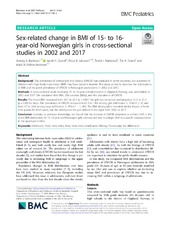Sex-related change in BMI of 15- to 16-year-old Norwegian girls in cross-sectional studies in 2002 and 2017
Bjertnæs, Asborg Sine Aanstad; Grundt, Jacob Holter; Juliusson, Petur Benedikt; Markestad, Trond Jacob; Strand, Tor A; Holten-Andersen, Mads Nikolaj
Peer reviewed, Journal article
Published version

Åpne
Permanent lenke
https://hdl.handle.net/1956/22179Utgivelsesdato
2019-11-12Metadata
Vis full innførselSamlinger
Originalversjon
https://doi.org/10.1186/s12887-019-1790-2Sammendrag
Background: The prevalence of overweight and obesity (OWOB) has stabilized in some countries, but a portion of children with high body mass index (BMI) may have become heavier. This study aimed to describe the distributions of BMI and the point prevalence of OWOB in Norwegian adolescents in 2002 and 2017. Methods: A cross-sectional study involving 15- to 16-year-old adolescents in Oppland, Norway, was undertaken in 2002 and 2017. We calculated their BMI, BMI z-scores (BMIz), and the prevalence of OWOB. Results: The mean BMI increased from 20.7 to 21.4 (p < 0.001) for girls but remained unchanged at 21.5 vs 21.4 (p = 0.80) for boys. The prevalence of OWOB increased from 9 to 14% among girls (difference 5, 95% CI: 2, 8) and from 17 to 20% among boys (difference 3, 95% CI: − 1, 6%). The BMI density plots revealed similar shapes at both time points for both sexes, but the distribution for girls shifted to the right from 2002 to 2017. Conclusion: Contrary to previous knowledge, we found that the increase in OWOB presented a uniform shift in the entire BMI distribution for 15–16-year-old Norwegian girls and was not due to a larger shift in a specific subpopulation in the upper percentiles. Keywords: Adolescent, Body mass index, Body mass index distribution, Obesity, Overweight, Sex differences
